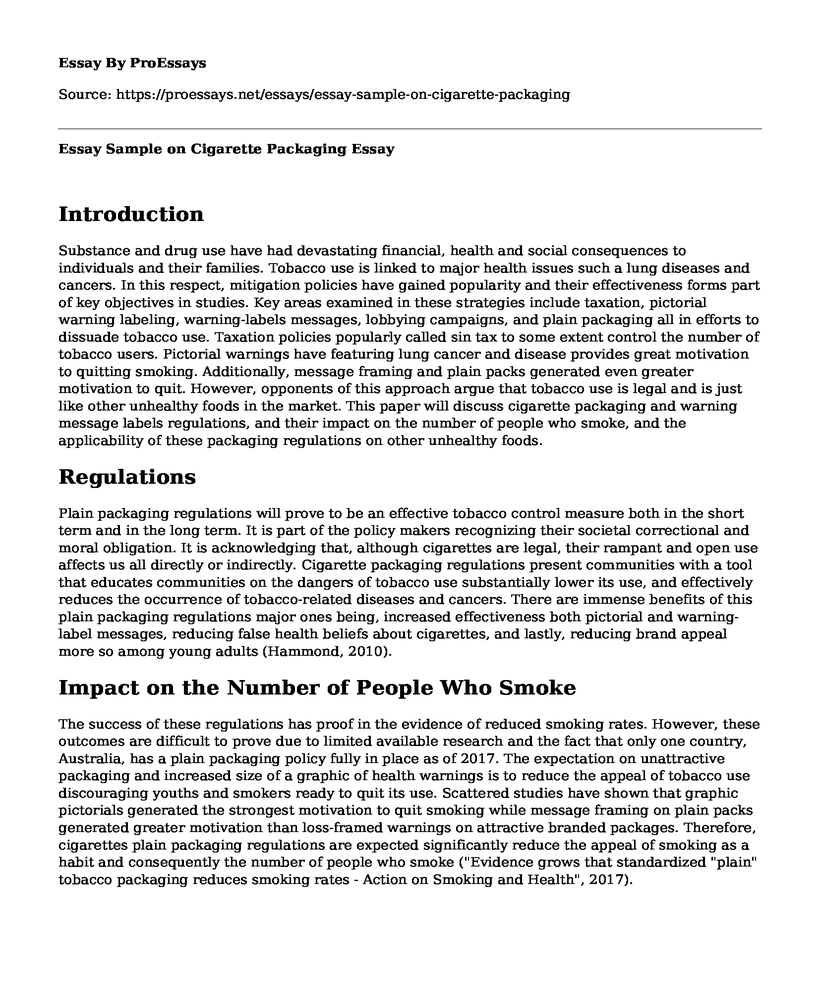Introduction
Substance and drug use have had devastating financial, health and social consequences to individuals and their families. Tobacco use is linked to major health issues such a lung diseases and cancers. In this respect, mitigation policies have gained popularity and their effectiveness forms part of key objectives in studies. Key areas examined in these strategies include taxation, pictorial warning labeling, warning-labels messages, lobbying campaigns, and plain packaging all in efforts to dissuade tobacco use. Taxation policies popularly called sin tax to some extent control the number of tobacco users. Pictorial warnings have featuring lung cancer and disease provides great motivation to quitting smoking. Additionally, message framing and plain packs generated even greater motivation to quit. However, opponents of this approach argue that tobacco use is legal and is just like other unhealthy foods in the market. This paper will discuss cigarette packaging and warning message labels regulations, and their impact on the number of people who smoke, and the applicability of these packaging regulations on other unhealthy foods.
Regulations
Plain packaging regulations will prove to be an effective tobacco control measure both in the short term and in the long term. It is part of the policy makers recognizing their societal correctional and moral obligation. It is acknowledging that, although cigarettes are legal, their rampant and open use affects us all directly or indirectly. Cigarette packaging regulations present communities with a tool that educates communities on the dangers of tobacco use substantially lower its use, and effectively reduces the occurrence of tobacco-related diseases and cancers. There are immense benefits of this plain packaging regulations major ones being, increased effectiveness both pictorial and warning-label messages, reducing false health beliefs about cigarettes, and lastly, reducing brand appeal more so among young adults (Hammond, 2010).
Impact on the Number of People Who Smoke
The success of these regulations has proof in the evidence of reduced smoking rates. However, these outcomes are difficult to prove due to limited available research and the fact that only one country, Australia, has a plain packaging policy fully in place as of 2017. The expectation on unattractive packaging and increased size of a graphic of health warnings is to reduce the appeal of tobacco use discouraging youths and smokers ready to quit its use. Scattered studies have shown that graphic pictorials generated the strongest motivation to quit smoking while message framing on plain packs generated greater motivation than loss-framed warnings on attractive branded packages. Therefore, cigarettes plain packaging regulations are expected significantly reduce the appeal of smoking as a habit and consequently the number of people who smoke ("Evidence grows that standardized "plain" tobacco packaging reduces smoking rates - Action on Smoking and Health", 2017).
Labels Used on Unhealthy Foods
Equally, there are food choices in the market that also result in serious health issues in the long-term. The foods attractiveness stems from their packaging that is behind the brand appeal. Attractive advertising has also draw consumers to these food-like products but which have no health benefits. Therefore, to dissuade their use just like cigarettes, plain packaging policies can find application on these products too.
Conclusion
Manufacturing, distribution, importation, and use of cigarettes are legal but manufacturers have to comply with the plain packaging policies. The regulations intended benefits include increased effectiveness of health-warning messages and reduced cigarettes and brand appeal. Consequently, the expected impact is the reduced number of smokers. Evidence of the success of this mitigation strategy informs the opinion on extension of these plain packaging regulations to unhealthy foods.
References
Evidence grows that standardised "plain" tobacco packaging reduces smoking rates - Action on Smoking and Health. (2017). Retrieved from http://ash.org.uk/media-and-news/press-releases-media-and-news/evidence-grows-that-standardised-plain-tobacco-packaging-reduces-smoking-rates/
Hammond, D. (2010). "Plain packaging" regulations for tobacco products: the impact of standardizing the color and design of cigarette packs. Salud Publica De Mexico, 52, S226-S232. doi: 10.1590/s0036-36342010000800018
Cite this page
Essay Sample on Cigarette Packaging. (2022, Nov 08). Retrieved from https://proessays.net/essays/essay-sample-on-cigarette-packaging
If you are the original author of this essay and no longer wish to have it published on the ProEssays website, please click below to request its removal:
- Research Paper on Women's Health: Cervical Cancer Screening Guidelines for Ages 20-29
- Paper Example on Inditex: World's Largest Fashion Retailer With 8 Product Types
- Ebola Virus Disease - Deadly Acute Illness Since 1976 - Research Paper
- Essay on Loyalty Rewarded: Assessing the Impact of Consumer Effort on Random Marketing Outcomes
- Paper Example on Age-Related Changes: Nutritional Challenges & Health Risks
- Labor Formation Comparison: Germany vs USA - Free Essay Sample
- Leading Change: The Essential Role of Managers - Free Essay Sample







